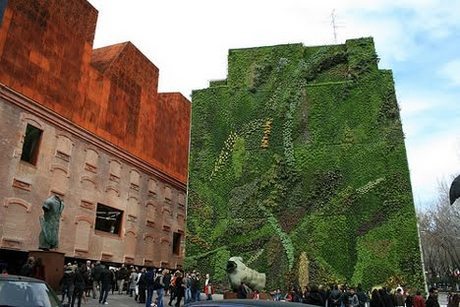CaixaForum Museum
The CaixaForum Madrid is a new cultural center in the historical center of Madrid, near the renowned Prado, Reina Sofia and Thyssen-Bornemisza museums, designed by Swiss architects Herzog & de Meuron, the 2001 Pritzker Architecture Prize winners. The CaixaForum is a restoration and expansion of one of the few examples of industrial architecture in Madrid’s historical center, the old power plant Central Eléctrica del Mediodía. Herzog & de Meuron used four basic principles to redesign of the building: to restore the brick outer layer using traditional techniques, to get rid of the stone base around the power plant, to open up a new public square with an entrance on Paseo del Prado and to add volume.
So far, there are exhibitions of Florence including the Uffizi, the graphic artist Alphonso Mucha, Charlie Chaplin and the master of Fauvism Maurice de Vlaminck. Caixa Forum, not only in exhibitions, there are also concerts, films and conferences and workshops.
The seven-floor, brick and cast iron building hold art exhibitions, film screenings, concerts and conferences. The building is a really representative example of industrial architecture: 19th-century brick walls have been retained, but raised on piers so that visitors can walk underneath the building. The stairs inside the museum are also really impressive and are worth to be seen. Do not also miss to check out the 24-metre high vertical garden that takes up one wall of the square in front of the building. Comprising 15,000 plants of 250 different species, it has been designed by the French botanist Patrick Blanc. This garden symbolizes a bridge with the botanical garden on the opposite side of the Paseo del Prado.
CaixaForum is Madrid's latest cultural and architectural star. It is one of those sights where the building is as much of an attraction as the content found in the interior. Once through the doors, visitors are then drawn to another curious sight, a staircase that could easily be mistaken for a Gaudi creation found in Barcelona. In reality, however, the entire extraordinary building is by the famous Swiss duo Herzog and De Meuron, best known for designing the Tate Modern in London that led to their Pritzker Award win.
The location chosen by La Caixa Foundation for its new Madrid home naturally had to be in the vicinity of the Prado, the Reina Sofia, and the Thyssen-Bornemisza museums, so for that an old power plant had to be restored and expanded. It is now one of the Spanish capital's best examples of industrial architecture, and one of its must-see sights.
The exhibitions feature works from the foundation's permanent collection (some 700 pieces by artists from the 1980s to the present), as well as temporary displays from other museums and foundations.
In addition to the exhibition space, the complete $36-million cultural center includes a bookshop, a restaurant, and an auditorium that hosts concerts and conferences.
Whoever enters the remarkable input ends up in a room where a library and an art bookstore are located. On the left is an information desk where an agenda of activities is available on everything that occurs in the Caixa Forum. On the floors above, which are accessible by lift, is the museum with changing exhibitions.
One of the advantages of the museum is free access and an excellent choice for a morning or afternoon to spend and enjoy the art that you encounter. Opening hours are from Tuesday to Sunday from 10.00 to 20.00 hours. You can get there via flight to Madrid.




